First Grade Writing: Non-Realistic Fiction
Teaching non-realistic fiction writing can be such a fun topic for first grade students to explore. On the other hand, teaching a child how to write in first grade can be one of the most challenging aspects of teaching. In fact, this is perhaps the biggest struggle for many teachers in my private Facebook group. While we are talking about this struggle, let’s be honest: not all kids love to write. However, when implemented effectively, teaching a 1st grader how to write can be incredibly rewarding! There is so much growth by the end of the school year. In order for this growth to happen, students need opportunities to write every single day. Explicit writing instruction must take place for students to progress.
Today we will be talking about Unit 2: Non-Realistic Fiction: Showing Not Telling! This First Grade Writing Curriculum has EVERYTHING you need to teach writing! Each unit has 22 days of scripted lesson plans that will help you implement an effective Writers Workshop program with your students! All of the hard work has been done for you! In a Writers’ Workshop our goal is to foster good writing habits in young authors in order to help build a routine. Therefore, a solid routine for daily writing will help students hone their craft and become strong and fluid writers! In Writer’s Workshop, the focus is entirely on the writer and meeting them where they are in the writing process. Our goal is to move them forward to the next stage of grade-appropriate developmental writing! Writer’s Workshop will help sustain students throughout a variety of genres and styes of writing!
I’m excited about this writing curriculum, so let’s get started and take a look at Unit 2!
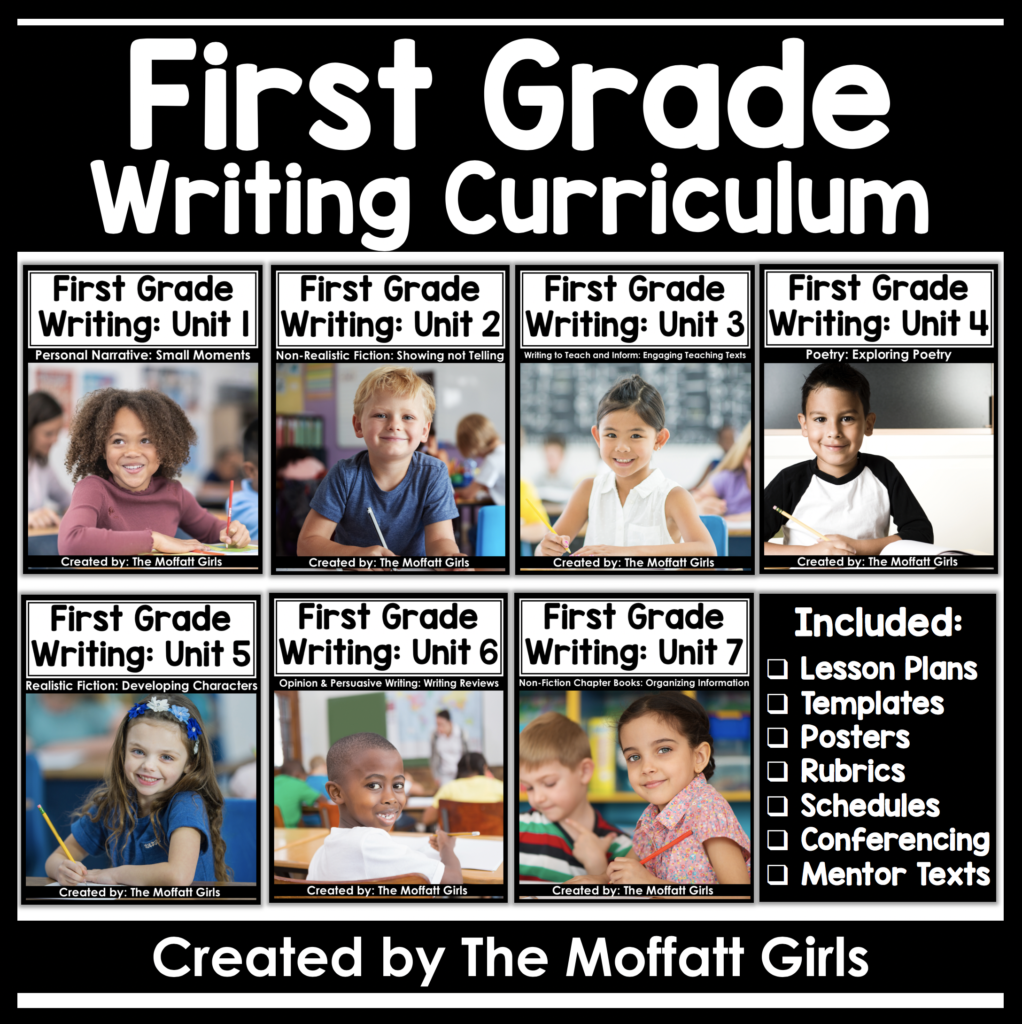
FIRST GRADE WRITING CURRICULUM SCOPE:
- Unit 1: Personal Narrative: Small Moments
- Unit 2: Non-Realistic Fiction: Showing Not Telling
- Unit 3: Writing to Teach & Inform: Engaging Teaching Texts
- Unit 4: Poetry: Exploring Poetry
- Unit 5: Realistic-Fiction: Developing Characters
- Unit 6: Opinion & persuasive Writing: Writing Reviews
- Unit 7: Non-Fiction Chapter Books: Organization Information

LET’S TAKE A LOOK AT UNIT 2 IN THE 1ST GRADE WRITING CURRICULUM!

This First Grade Writing Curriculum uses a Writers Workshop type model. This means that there will be a mini-lesson, status updates (pre-writing, drafting, revising, editing, evaluating, or publishing), writing, and sharing! That might sound like a lot, but don’t worry… I have you covered on how to effectively implement this curriculum in your classroom or homeschool!
WHAT IS WRITER’S WORKSHOP?
Writer’s Workshop is a framework for writing instruction and practice. The following will be covered in the Writing Process:
- Research- Learn about a style of writing or topic. Read and look at great books to get ideas
- Planning: Decide on a topic and plan out your ideas.
- Writing: Use your plan to help you write your story.
- Revising: Improve your writing by adding details.
- Proofreading: Check your work. Use your resources to help you.
- Feedback: Ask others to read your story and give you ideas of how to improve it!
- Editing: Use the feedback you got from others to help make your story even better!
- Publishing: Make a neat copy of your book that is ready to share with the world!
WHAT IS INCLUDED IN UNIT 2: Non-Realistic Fiction?
- Tips for Getting Started (Classroom and Material Organization and Procedures)
- Developmental Writing Stages
- Unit Text (Mentor Text) Guides
- Conferencing Guides
- Conferencing Planner
- Conferencing Tracker
- Assessment Guide
- Rubrics and Rubric Guide
- Multiple Writing Templates
- Publishing Party Guide
- Publishing Party Supplies
- Unit Posters
- Non-Realistic Fiction Things We Can Write About
- The Writing Process Chart
- Writing Checklists
- Peer Editing Checklist
- Young Author Award
- Writing Folder Covers
- Pencil Organization Labels
- Writers Library Labels
- Alphabet Chart (full and mini size)
- Letter Formation Chart (full and mini size)
- Non-Realistic Fiction Charts:
- Beginning, Middle, and End
- Words We Use
- Small Moments Posters
- Zooming in on Small Moments
- Detailed Picture Poster
- Detailed Word Posters
- Cover of a Book Poster
- Writer’s Checklist (2 posters)
- I Can Write About…
- Adding Details to our Writing Poster
- Writing Checklist
- Alphabet Sounds Chart (full and mini size)
- Word Wall Personal Book (sight word copy and EDITABLE copy!)
- We Are Authors Banner
- 2 Wordless Picture Books
- Black and White Version Included
Let’s Start with the Lesson Plans:
These easy-to-follow lesson plans set you up for success. They are broken up into 6 simple parts:
Focus- The skill, strategy, or idea students will be focusing on this lesson.
Warm Up- A quick activity that has students review and practice previous skills.
Mini Lesson- Teach, model, and discuss the new skill in today’s lesson.
Practice- The hands-on portion of the lesson where students apply what they have learned in the mini lesson to their own writing. During this time you will conference individually with students.
Mid-Practice Teaching Point- A quick reminder and chance to highlight the great work students are doing.
Share- Lesson wrap-up where students analyze, reflect on, and share their work.


LESSON SCHEDULE:
I have also laid out what a lesson might look like with a 60 minute, 45 minute, and 30 minute time block. We all have different schedules, and this writing curriculum is designed to meet your needs! Do what works best for YOU!
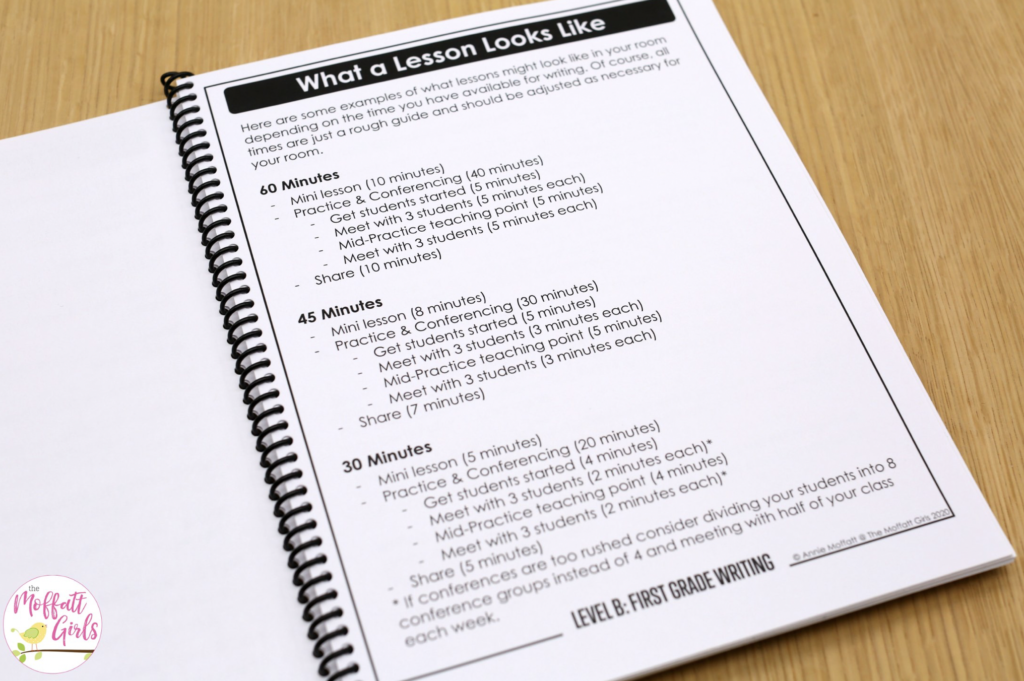
Also included are some tips for getting started! With this cohesive curriculum, I have set you up for success! All the work has been done for you. Just print out your materials and open up your lesson plans! Of course you will want to monitor students progress, and change your plans appropriately.
HERE IS AN OVERVIEW OF THE SCOPE FOR UNIT 2:

ORGANIZATION:
Each child will get his/her own writing folder. This folder will be the place where they keep all of their writing templates, charts, and materials.

Inside of each folder, you can include the Mini Posters, Phonics Helpers, writing templates and any other resources about the unit.
MENTOR TEXTS:
Mentor texts are an important component to each unit in the Writing Curriculum.
What are Mentor Texts? Mentor text(s) are 1-2 example texts that illustrate the writing style we are focusing on for the unit.
For the First Grade Non-Realistic Fiction, here are some examples of mentor texts you can use in your Writers Library:
- “Giraffes Can’t Dance” by Giles Andreae
- “Creepy Carrots” by Aaron Reynolds
- “I Need My Monster” by Amanda Roll
- “No More Noisy Nights” by Holly Niner
- “The Night I Followed the Dog” by Nina Laden

A Writers Library is a larger collection of on-topic texts that students can read and reference throughout the unit. Consider keeping these books in a special location where students can access them throughout the unit.
“Little Red Writing” by Joan Holub, which is a great way to introduce students to non-realistic fiction writing. Consider using it in Lesson 2 to help students start brainstorming ideas and think about the writing process.
POSTERS:
Posters help students understand what the specific genre of writing includes. In this non-realistic fiction writing unit, a strong emphasis is placed on differentiating between realistic fiction and non-realistic fiction.




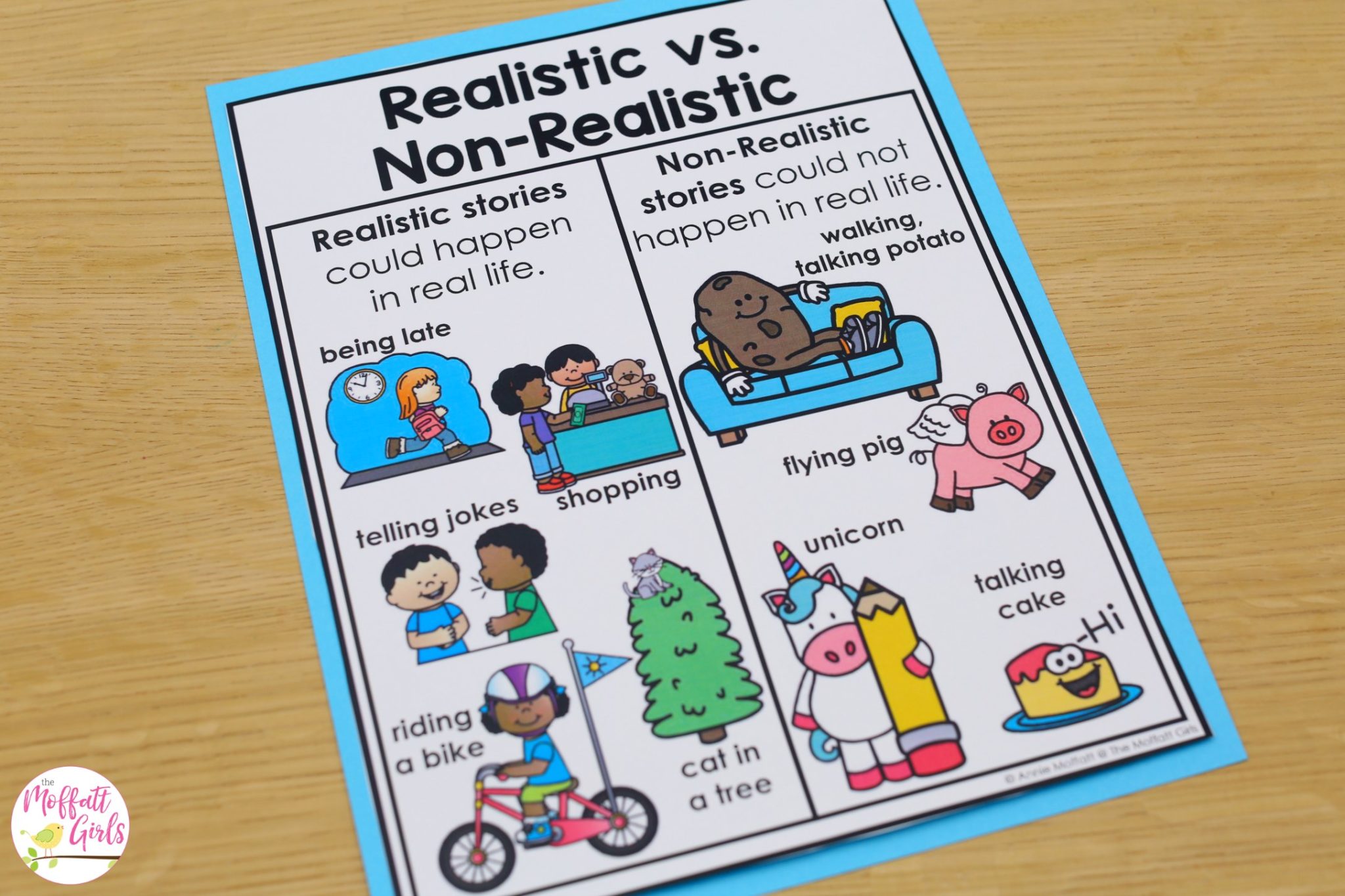
A Writer’s Checklist can be used during small groups to help students edit their non-realistic fiction writing once they get to that stage.

The Writing Process poster will help keep students on track as you move from lesson to lesson. This will highlight where they are in the writing process and what is coming next.

Use the Setting and Characters posters to help students understand the story elements for non-realistic fiction writing.

Additional posters like the Writer’s Checklist, Adding Details and parts of a non-realistic fiction story will help keep students on the right track.



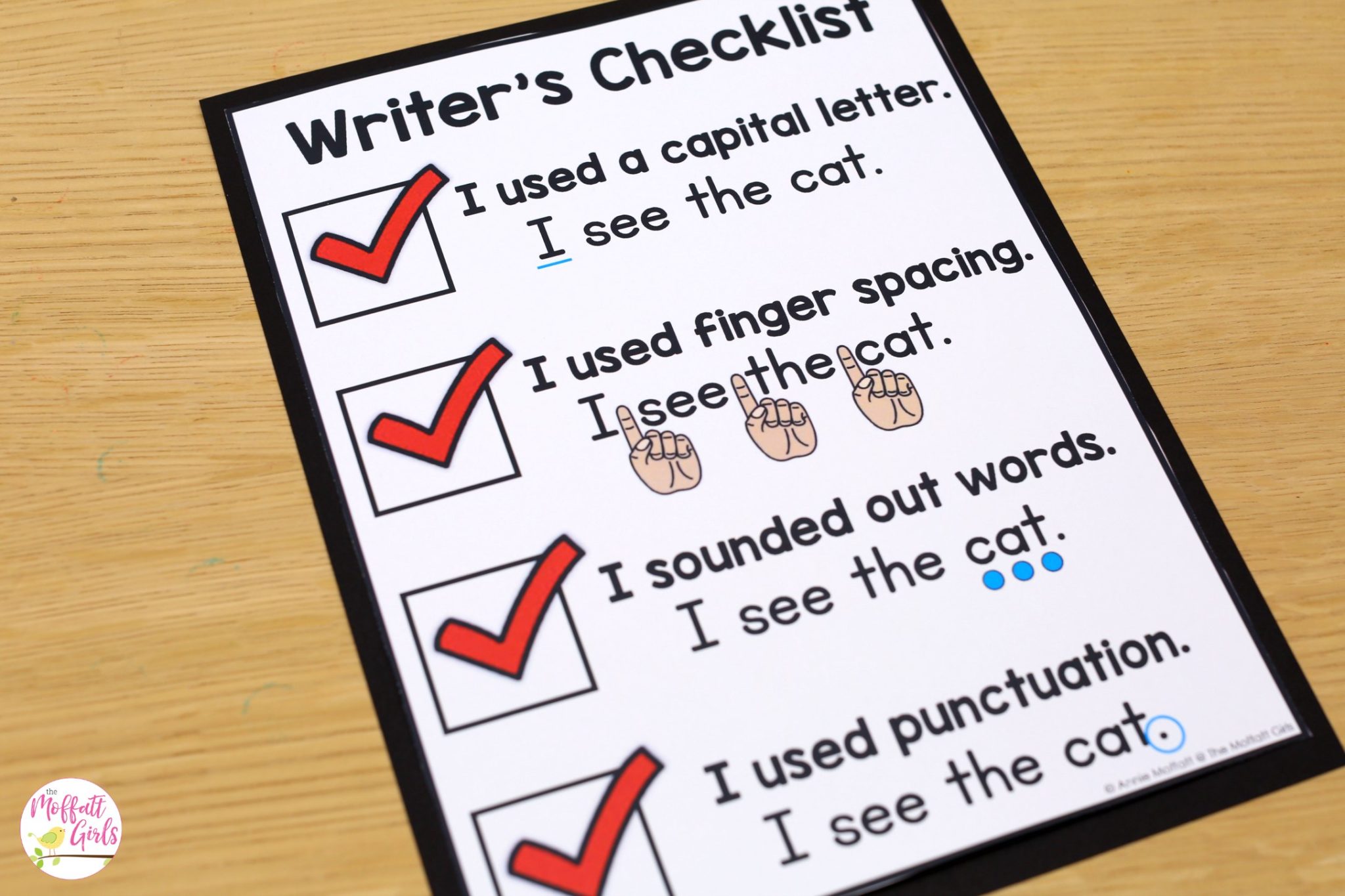
All posters are available in a mini version for students to use as a resource ring. They can be placed inside their writing folder.



Personal Word Wall folders can be used for keeping track of sight words or any other words that students want to know how to spell. I have also included an editable version.


PLANNING STAGE:
During Lesson 2, students will start planning their non-realistic fiction writing. As we remind students that a non-realistic fiction story is a made-up story that could not happen in real life, we direct them to fill in their idea chart. They will pick a topic and start planning their story! The posters can help students talk about and generate ideas related to the genre.


TEMPLATES
The unit includes templates to get students started by mapping out their non-realistic fiction story with pictures. They will start by choosing a character and a setting.

Next, we guide students into mapping out the beginning, middle and end of their story. Before students attempt to do any of these activities on their own, we use one of the mentor texts listed above to model what this will look like.

Choose the template of your choice from the Level B Writing Templates. Any non-realistic fiction book can be used as an example to model. When you read a selected picture book together, use the template to model identifying the main characters, setting, beginning, middle and end of the story. This will show students how to use the template to map out their own writing. Modeling story mapping is EXTREMELY important!



DEVELOPMENTAL STAGES OF WRITING APPROPRIATE FOR FIRST GRADE:
While all students develop differently, most student writing progresses along these developmental writing stages. Therefore, use this chart to determine a student’s current writing level and identify next steps and goals. Keep in mind, it is normal for students to progress through some stages quickly and linger at others. The most important thing is that we meet students where they are and move them forward in the process.

- Pre-Writing Stage:
- Pictures
- Random Scribbling
- Linear Scribbling. Scribbling moves from left to right
- Letter-like Symbols
- Random Letters. Letters do not correspond to sounds.
- Beginning Writing Stage:
- Letter Strings- child can “read” writing.
- Letter Groups
- Labeling Pictures
- Copying Print (Writer can’t read their writing.
- Sound Writing:
- Beginning Sounds
- Beginning and Ending Sounds
- Medial Sounds
- Fluent Writing:
- Phrase Writing
- Mixed Sound and Recall Spelling
- Sentence Writing
- All Syllables are Represented
- Paragraph Writing


Conferencing is the heart of Writer’s Workshop! This is where you will work with your small groups and get a good feel of where they are in their writing. Certainly keep in mind that you’re conferring with them. It’s an opportunity to provide individualized instruction, assess students writing, reinforce skills taught during the mini-lessons.
HIGHLIGHTING STRENGTHS
When you confer with your students, you can identify their strengths and notice what they are doing well. Specifically, these moments are great opportunities to celebrate those strengths and help build self-confidence. As a result, students’ writing stamina grows as students learn what they are doing correctly.
IMPROVING WEAKNESSES
Conferencing also gives the chance for students to think about where they can improve their writing. Certainly you can easily make this your teaching point. You may want to pose questions during this time. For example, what else do good writers do? Suggestions could include adding more details. Or they might need to make sure their writing has a beginning, middle and end. Perhaps the student is working on labeling. Whatever the case, conferencing time is a time to set goals for something they can work on to improve their writing so they can become even better writers.
SCAFFOLDING
In light of the vigorous process, I have included Wordless Picture Books to help make this process more effective! Use the Wordless Picture Books to address specific writing goals with each group of students. Some may be working on labeling. Some might work on detailed pictures. By the end of the year, you will see students progress in the Developmental Stages of Writing and move onto write complete paragraphs and stories.

Laminate the Wordless Picture Books and use them to model what good writing looks like while meeting with your small groups. This is also a great option for teachers who, might we say, don’t have the best drawing skills  No drawing needed, just add the writing to each story!
No drawing needed, just add the writing to each story!
EDITING:
Editing also plays an important role in the writing process. Students will both self-edit and have a peer editing their work. For first grade non-realistic fiction, these grade-appropriate editing skills will focus on the following:
- I told a made-up story
- My story has a beginning, middle and end
- I have detailed words and pictures
- I used sounds and sight words
- I have a capital letter and punctuation
Each unit will focus on specific goals when editing. These teaching goals will be geared towards the writing unit and will slightly change from unit to unit. Here are the goals for the non-realistic fiction writing:

RUBRICS:

Rubrics provide a structured way to measure student writing ability. Use these rubrics to grade pre-unit on demands, post-unit on demands, and final writing pieces as needed. Most teachers find that grading all three writing pieces is not necessary.
Conveniently, there are several options of rubrics provided so you can select the rubric(s) that best fits your needs.

PUBLISHING PARTY:

Now it’s time for students to share their writing in Lesson 22! This is such an important component to Writer’s Workshop, especially in First Grade! Finally, the time has come to have a Publishing Party! Students have worked hard to complete 2 non-fiction stories, a perfect reason to celebrate their accomplishments!
Publishing parties look different in each room. The main thing is that each student gets a chance to share their work! For a small class, you could have students share one at a time. On the other hand, for a larger class you could have students share in small groups or sit at their desks while guests rotate around and see all of the books.
PLAN AHEAD:
Mark your publishing party on your class calendar at the beginning of the unit to help your students get excited. Additionally, during revision and publishing days remind your students that they are authors and an audience is coming to hear their stories!
The main goal of a publishing party is for students to celebrate and share their accomplishments as a writer. A variety of party supplies and props are provided including crowns, compliment pages, signs, party invitations, an “I’m an Author” banner and name tags. Use these to make your party something your students and families look forward to each unit. Let’s get this party started!


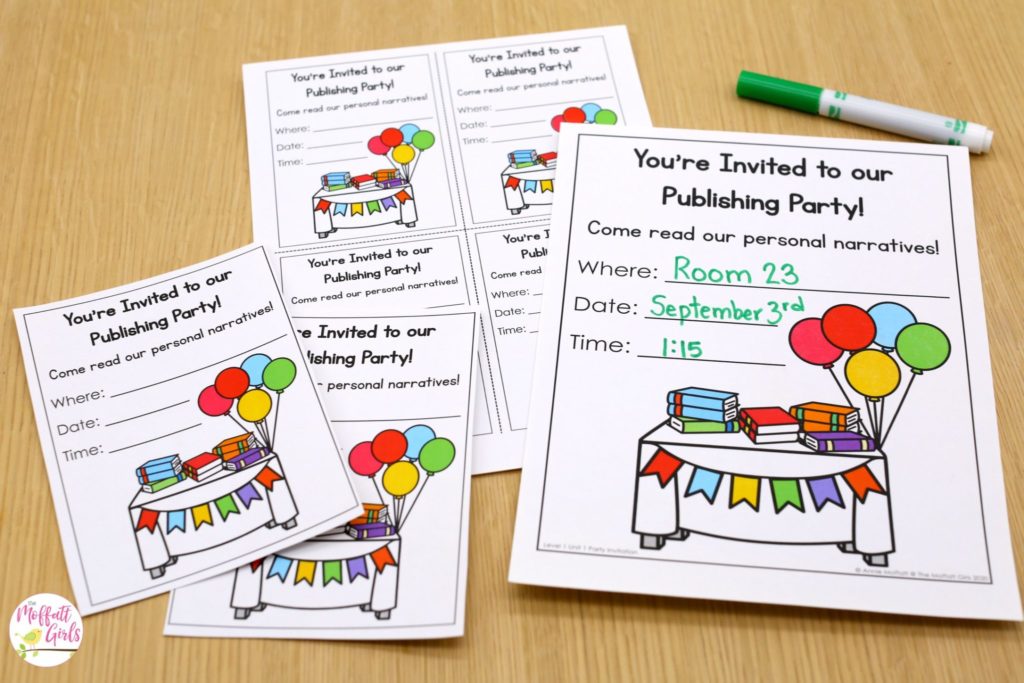


I hope this unit on non-realistic fiction writing helps you with teaching first grade writing!
Click Here to see the Kindergarten Writing Curriculum!
The post First Grade Writing: Non-Realistic Fiction appeared first on Moffatt Girls.

